| home | virtual field trips | regional geology | images | e-learning | links |
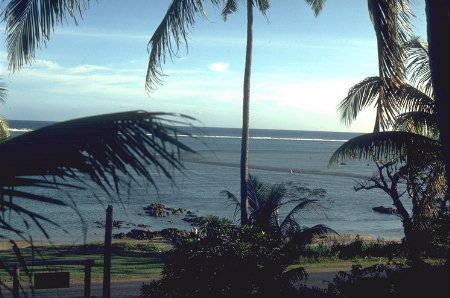
Thumbnail images of the slides are provided in the text of the 'lecture'. To see a larger version of any slide, simply click on it. Once you've looked at the slide, click the Back button to return to the main lecture. University of Derby students will find additional information and diagrams in the handouts which form part of the module.
Bodies of carbonate rock consisting largely of the skeletal remains of organisms are common in the Phanerozoic rock record. Confusion has arisen over how to classify and name these, because of different usage by different workers. The term build-up is often used to describe
"locally formed limestone bodies which had original topographic relief" (Tucker, 1991), or
"thick carbonate deposits of limited lateral extent built essentially of organisms..." (Scoffin, 1987).
A build-up can be defined as:
any carbonate rock body composed mainly of fossil organisms, regardless of the shape or mode of origin of the rock body.
A build-up is equivalent to the term reef as used in its loosest sense. Wright and Burchette (1996) describe a reef as:
"any biologically influenced carbonate accumulation which was large enough to have developed topographic relief above the sea floor".
Other carbonate workers restrict the term reef to build-ups with a rigid organic framework.
Most, but not all, build-ups were features of positive relief on the sea floor at the time of their formation. Others may have been at sea floor level, and kept pace with surrounding sedimentation.
1. Bioherms - these are mound- or lens-shaped. Some are in-place organic structures (reefs), others are banks of loose, transported carbonate sediment consisting largely of shells or skeletons.
 |
slide - bioherms & biostromes |
2. Biostromes - laterally extensive beds, sheets or ribbons of carbonate material. Some have grown in-place (reefs); others consist of transported shells and skeletons.
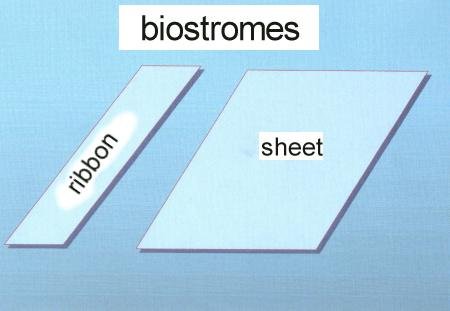 |
slide - biostrome forms |
3. Reefs
Reefs in the strict sense have a rigid framework built of the skeletons of carbonate-secreting organisms. These sediment bodies may be lens, ribbon or sheet-shaped. They are dealt with in detail below.
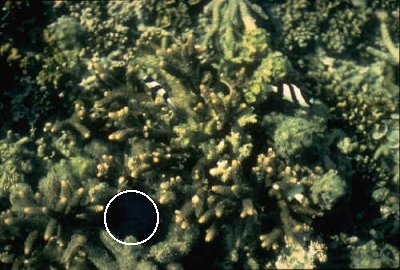 |
slide - modern reef |
4. Mud mounds and mud banks are often formed by trapping of mud-sized calcium carbonate (micrite) by various organisms. Again, we will look at these in more detail later.
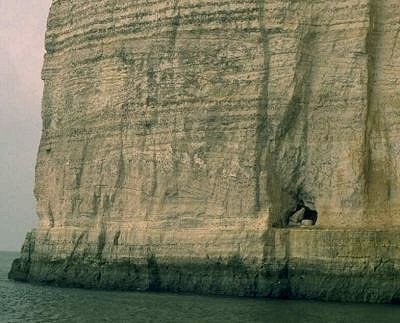 |
slide - Cretaceous micrite mounds |
Carbonate build-ups often form barriers along a shelf edge, separating shallow marine shelf sediments from deeper water slope and basin facies. Let us now look at each of the types of build-up in more detail:
R. Riding (1989) provided this definition of a reef:
"Organic reefs are in-place calcareous deposits with topographic relief, created by sessile organisms."
In all cases, the reef exists because of the presence of reef-building organisms, but reef structure may be dominated by:
(after R. Riding, 1989)
In order to survive, the organisms must:
The success of reefs depends on factors which have varied through geological time, especially:
(after R. Riding, 1989)
Thus, reefs reflect interaction of a number of variables, including:
Conditions for modern reef development: Modern reefs are highly dependent on the requirements of the main reef builders, scleractinian corals and calcareous algae, as follows:
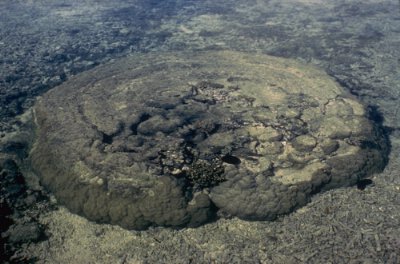 |
slide - modern coral reef requirements |
Diversity is reduced by:
The morphology of coral colonies and other reef builders is controlled by environmental energy and substrate. For example, on a hard sea floor, many corals are attached, with hemispherical form. More delicate, branching forms occur in lower energy environments, e.g. below the surf zone. In the high wave energy environment, encrusting and tabular forms may dominate.
 |
slide - coral forms |
Often, a zonation may be seen in the morphology of the reef formers on different parts of the reef.
There are three main types of modern reef:
Fringing reefs are continuous with the shoreline at low tide - there is no lagoon.
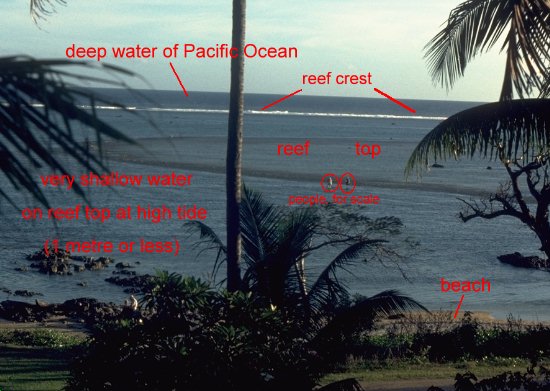 |
slide -Fiji fringing reef |
Passages in the reef coincide with rivers. Because of the influx of fresh water, sand and mud, reef builders such as scleractinian corals and calcareous red algae are unable to survive in these narrow zones. Thus, the input of river water and clastic sediment controls the distribution of carbonate-producing organisms on the fringing reef.
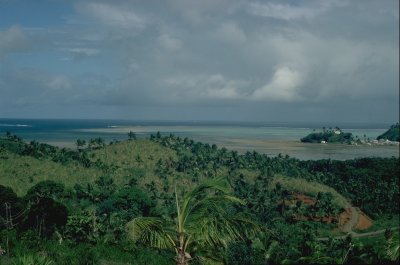 |
slide - passage through fringing reef |
Some of the clastic sediment is trapped by vegetation before it reaches the reef environment.
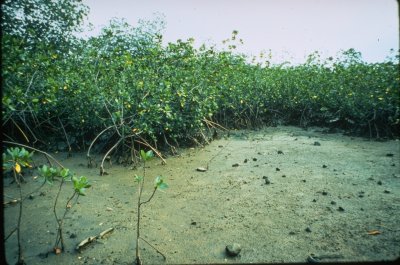 |
slide - sediment trapping in mangrove swamp |
Barrier reefs are usually on a larger scale than fringing reefs. The reef is separated from the land by a permanent lagoon, in which low energy environments may predominate, due to the sheltering effect of the reef. The lagoon may connected with the sea by tidal channels. The GBR is a very high energy environment, with very long wave fetches across the Pacific Ocean. For this reason, the exposed reef front can only be visited on about 9 days each year.
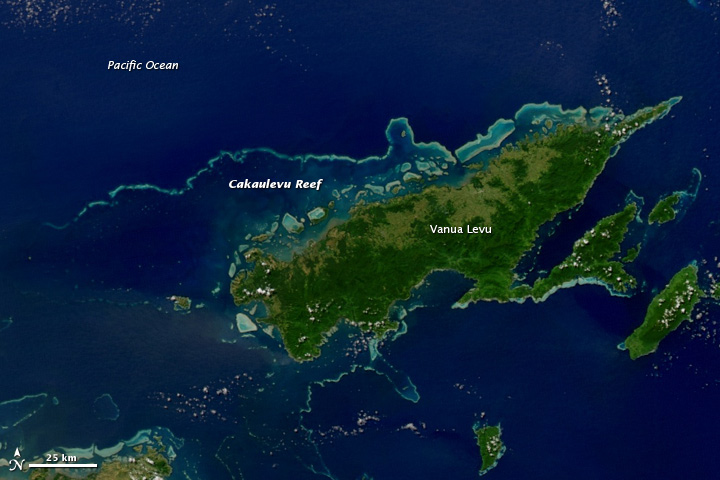 |
NASA image |
The salinity of the lagoon may vary: if connections to the open ocean are good, normal marine salinities may predominate. High evaporation rates and restricted connections to the ocean may result in raised salinity, even hypersalinity. Influx of large volumes of river water into the lagoon may lower the salinity. Abnormally high or low salinity will have an effect on the sediment-forming organisms present in the lagoon.
Barrier reefs occur on a variety of scales. The largest modern example, the Great Barrier Reef (GBR) off NE Australia, is 2000 km long, and 16 to 320 km wide. Explore
On a smaller scale, patch reefs often occur in the lagoon behind a barrier reef. Pinnacle reefs may also occur on the fore-reef side.
Atolls are areas of shallow water carbonate deposition in the open ocean. Most have a volcanic core. An essential feature is the central lagoon.
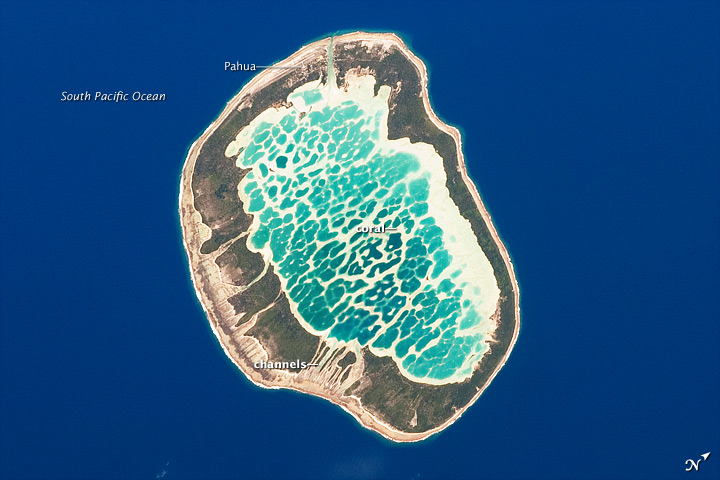 |
NASA image
|
The diagram below shows the evolution from fringing reef to barrier reef to atoll with time on oceanic volcanic islands. This is Charles Darwin's model, based on his experiences on the voyages of the Beagle. The oceanic lithospheric plate subsides as it moves away from the ridge and cools. If the reef-building organisms are unable to construct at a rate at least equal to the subsidence rate, eventually the reef is drowned.
 |
slide - reefs around ocean islands |
next |
Lecture 1: IntroductionLecture 2: Modern Reefs and BuildupsLecture 3: Reefs and Buildups through Time |
JAMES, N.P. 1983. Reefs. Chapter 8 in SCHOLLE, P.A., BEBOUT, D.G. & MOORE, C.H.: Carbonate Depositional Environments. American Association of Petroleum Geologists, Memoir 33. Tulsa.
SCOFFIN, T.P. 1987. An Introduction to Carbonate Sediments and Rocks. Blackie. Chapter 7 - Reef growth, pp. 77-88.
TUCKER, M.E. 1991. Sedimentary Petrology. Blackwell Scientific Publications. Section 4.10.6 - Reefs and carbonate buildups, pp. 159-162.
WRIGHT, V.P. & BURCHETTE, T.P. 1996. Shallow-water carbonate
environments. In: READING, H.G. (ed.), Sedimentary Environments: Processes,
Facies and Stratigraphy. Blackwell Science. Section 9.4.5 - Reefs, pp. 368-378
![]()
This page is maintained by Roger Suthren. Last updated 16 March, 2021 3:15 PM